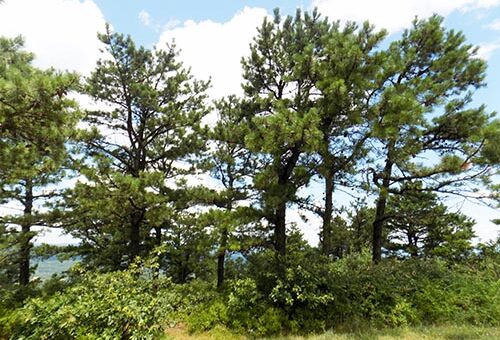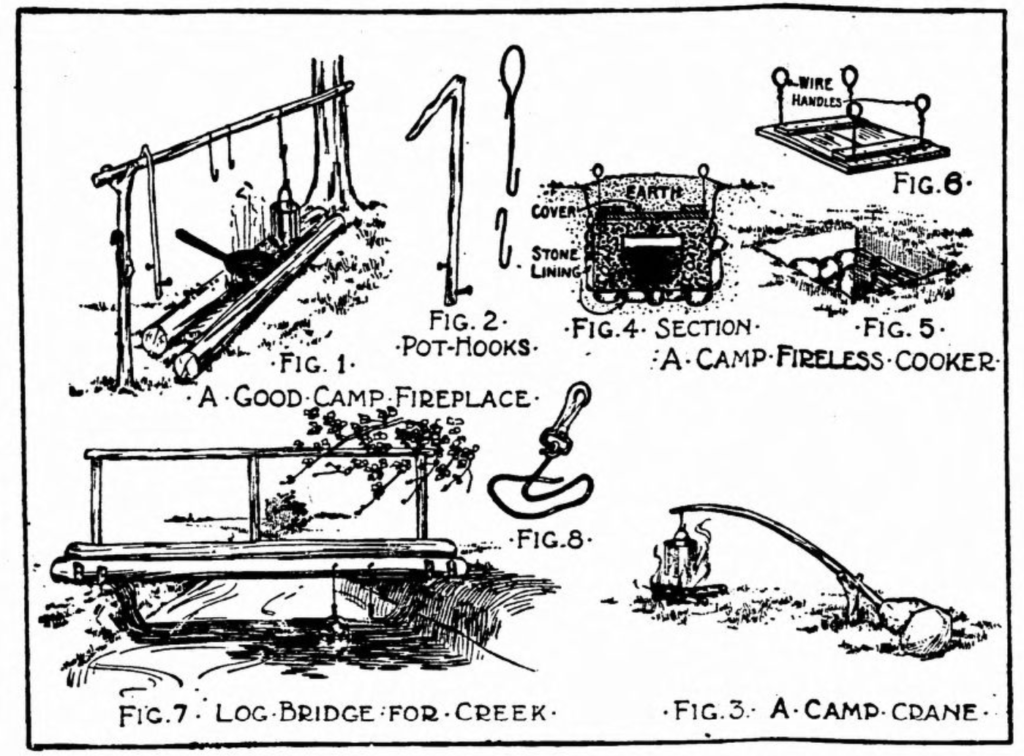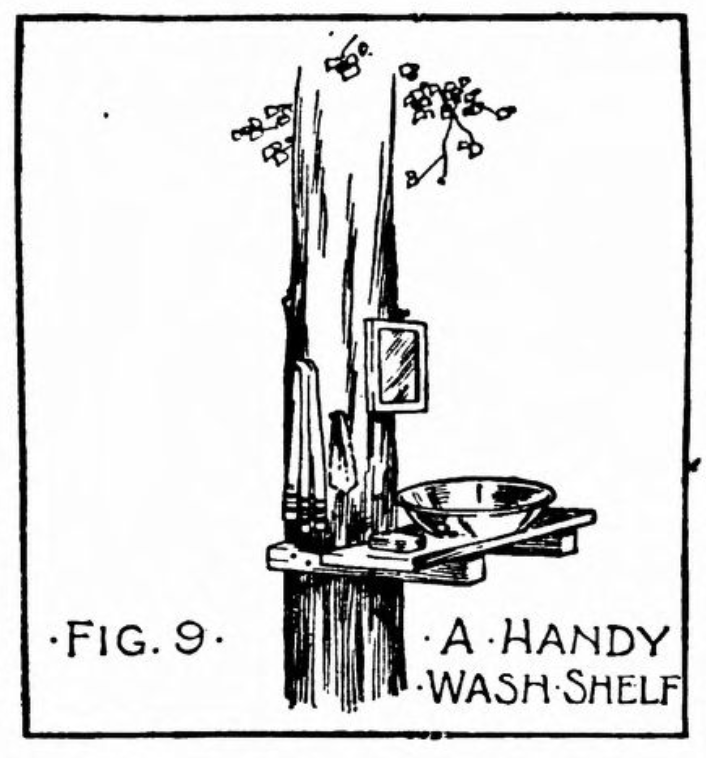
The following camping tricks were originally published in 1913 and give some interesting ideas for people who want to rough it out in the woods. The fireless cooker made with stones and fire embers is especially interesting and has been shown in a few survivalist shows.
When You Go Camping
The handy boy seldom remains a tenderfoot long upon his first camping trip, because having learned resourcefulness he is quick to adapt himself to his new surroundings, and is generally able to find his way out of difficulties and to make a pretty good guess as to how things in general should be done. For this reason, things usually go along more smoothly for the handy boy than for the boy who never had to make himself useful at home, and has been allowed to shirk responsibilities.

Camping is a splendid experience for all boys, and the less equipment they can get along with the more practical good they will gain from the trip. With careful planning, the amount of equipment can always be cut down to a minimum. Even if the camp is to be in the back yard, or a nearby lot, the rule to “go light” should be observed.
The handy boy will think of lots of things to make while in camp, and he should not fail to take along an axe, hammer, saw, jack knife, nails of several sizes – including a supply of spikes – tacks, screw hooks, screw eyes, staples, wire, cord, and rope, for tools and working material. Nails, hooks and staples may be carried in tin cans, but they will pack with less waste space in small bags made of canvas, denim, or burlap. These bags should be provided with drawstrings.
Open Fireplace
Unless a small sheet iron camp stove is taken along, you must build an open fireplace. Fig. 1 shows the backwoodsman’s scheme. Two logs are placed upon the ground side by side, with one pair of ends close together and the other ends about one foot apart, to form the sides of the fireplace. By slanting the logs in this fashion, small utensils can be set across the logs at the narrow end of the fireplace, and larger ones at the wide end. For suspending pails and other utensils over the fire, a horizontal pole, known as the lug-pole, should extend over the fireplace from one end to the other, upon which to hang pothooks. The illustration shows how one end of the lug-pole may be spiked to a tree and the other end supported in the crotch of a pole driven into the ground. The pothooks may be either short pieces of tree branches, with a fork left on one end large enough to hook over the lug pole, and one or two nails driven in near the other end upon which to hang utensils; or they can be made out of wire (Fig. 2). By making wire pothooks in short lengths, it is possible to hang your utensils at any height above the fire that you wish, and you can hang cooked food at the right height to keep it warm, without burning it.
Camp Crane
The camp crane shown in Fig. 3 furnishes another simple method of suspending food over a fire. Often times a small sapling will be in such a position that it can be bent over for such a crane. The end of the pole can be notched to catch the pail or kettle handle, or a small wire hook can be fastened to it.
Fireless Cooker
The fireless cooker is becoming more and more popular in camps because it makes it possible to cook the supper meal in it during the days without requiring any one member of the camping party to remain behind to keep up a fire.
Here is a good method of preparing a camp cooker. Dig a hole in a high and dry part of your camp ground, about 2 feet square and 2 feet deep, and line the bottom and sides with stones. Then batten several boards together to form a cover that will slip part way down into the hole (Figs. 4 and 6), and fasten four pieces of wire to it for handles (Fig. 6).
Your pot of beans, kettle of potatoes, oatmeal, mush, or whatever you intend to cook in the cooker, must be started upon your camp fire. While it is cooking, build a good wood fire in your cooker pit, and allow it to burn down into hot embers. Then quickly transfer your cooking utensils, when ready, into the cooker, raking a hole in the embers for it to set in, and fill in around and over the utensil with coals from your large fire. The wooden cover should be fitted down over the top, and the space between this and the ground level should be filled with earth to make the insulation as perfect as possible.
Log Bridge
A little creek is often in the vicinity of a camp site, and a handy crossing is not always found. If this creek is not very wide, it is a simple matter to throw two logs across it at the desired point of crossing. Boys do not require a railing on such a bridge, of course, but if girl visitors are expected it is a good plan to provide a railing such as is shown in Fig. 7. The end railing uprights should be driven into the ground, and these and a pair of stakes driven into the ground on the other side of the log ends should be spiked to the logs to keep them from rolling.
If your camp is located near a lake, you will probably want a pier, and a short one can be built on the plan of the creek bridge. Of course, the outer ends of the logs must be supported upon a couple of stout stakes driven a foot or more into the lake bottom and connected at the top with a crosspiece.
Use the water for your refrigerator. Drive a few nails into the side of the pier or creek bridge, and to each of these nails fasten a piece of stout cord with a snap hook (Fig. 8) tied to its end. The cords should be adjusted to the proper lengths to allow pails to become partially submerged in the water. A stone placed upon the covers of the pails will keep them from bobbing around and upsetting. The snap hooks will do away with having to untie the cord from the handles when removing the pails. This refrigerator should be located near shore, in the shade of a tree or reeds.

Tree Shelf
A shelf bracketed to a tree trunk, to hold a wash basin and soap, is a camp convenience that should not be overlooked (Fig. 9). Your mirror can be fastened above the basin, and a few nails will hold your wash rags and towels.
Source: The Virginia enterprise. (Virginia, St. Louis County, Minn.), 06 June 1913.

